Langres
| Langres | ||
|---|---|---|
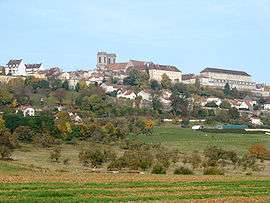 | ||
| ||
 Langres | ||
|
Location within Grand Est region  Langres | ||
| Coordinates: 47°51′48″N 5°20′02″E / 47.8633°N 5.3339°ECoordinates: 47°51′48″N 5°20′02″E / 47.8633°N 5.3339°E | ||
| Country | France | |
| Region | Grand Est | |
| Department | Haute-Marne | |
| Arrondissement | Langres | |
| Canton | Langres | |
| Intercommunality | Étoile de Langres | |
| Government | ||
| • Mayor (2014–2020) | Sophie Delong | |
| Area1 | 22.33 km2 (8.62 sq mi) | |
| Population (1999)2 | 9,586 | |
| • Density | 430/km2 (1,100/sq mi) | |
| Time zone | CET (UTC+1) | |
| • Summer (DST) | CEST (UTC+2) | |
| INSEE/Postal code | 52269 / 52200 | |
| Elevation |
327–475 m (1,073–1,558 ft) (avg. 475 m or 1,558 ft) | |
|
1 French Land Register data, which excludes lakes, ponds, glaciers > 1 km² (0.386 sq mi or 247 acres) and river estuaries. 2 Population without double counting: residents of multiple communes (e.g., students and military personnel) only counted once. | ||
Langres (French pronunciation: [lɑ̃ɡʁ]) is a commune in northeastern France. It is a subprefecture of the department of Haute-Marne, in the region of Grand Est.
History
As the capital of the Romanized Gallic tribe the Lingones, it was called Andematunnum, then Lingones, and now Langres.
The town is built on a limestone promontory of the same name. This stronghold was originally occupied by the Gauls, and, at a later date the Romans fortified the town belonging to the Celtic tribe the Lingones; Andemantunum the strategic cross-roads of twelve Roman roads. The 1st century Triumphal Gate and the many artefacts exhibited in the museums are witnesses to the Gallo-Roman town.
After the period of invasions, the town prospered in the Middle Ages due, in part, to the growing political influence of its bishops. The diocese covered Champagne, the Duchy of Burgundy and Franche-Comté, and the bishops gained the right to coin money in the 9th century and to name the military governor of the city in 927. The Bishop of Langres was a duke and peer of France. The troubled 14th and 15th centuries were reason enough for the town to strengthen its fortifications, which still give the old part of the city its fortified character, and Langres entered a period of royal tutelage. The Renaissance, which returned prosperity to the town, saw the construction of numerous fine civil, religious and military buildings that still stand today. In the 19th century, a "Vauban" citadel was added.
Climate
| Climate data for Langres (1981–2010 averages) | |||||||||||||
|---|---|---|---|---|---|---|---|---|---|---|---|---|---|
| Month | Jan | Feb | Mar | Apr | May | Jun | Jul | Aug | Sep | Oct | Nov | Dec | Year |
| Record high °C (°F) | 14.5 (58.1) |
17.7 (63.9) |
21.9 (71.4) |
26.2 (79.2) |
29.8 (85.6) |
34.1 (93.4) |
35.9 (96.6) |
37.6 (99.7) |
31.6 (88.9) |
25.7 (78.3) |
21.1 (70) |
15.5 (59.9) |
37.6 (99.7) |
| Average high °C (°F) | 3.4 (38.1) |
5.1 (41.2) |
9.4 (48.9) |
13.1 (55.6) |
17.4 (63.3) |
20.8 (69.4) |
23.5 (74.3) |
23.2 (73.8) |
18.9 (66) |
13.8 (56.8) |
7.6 (45.7) |
4.1 (39.4) |
13.4 (56.1) |
| Average low °C (°F) | −1.3 (29.7) |
−0.7 (30.7) |
2.1 (35.8) |
4.6 (40.3) |
8.7 (47.7) |
11.7 (53.1) |
13.9 (57) |
13.9 (57) |
10.6 (51.1) |
7.2 (45) |
2.4 (36.3) |
−0.3 (31.5) |
6.1 (43) |
| Record low °C (°F) | −18.1 (−0.6) |
−21.2 (−6.2) |
−13.2 (8.2) |
−6.6 (20.1) |
−2.9 (26.8) |
2.5 (36.5) |
5.1 (41.2) |
5.1 (41.2) |
2.1 (35.8) |
−4.5 (23.9) |
−10.7 (12.7) |
−16.4 (2.5) |
−21.2 (−6.2) |
| Average precipitation mm (inches) | 80.5 (3.169) |
64.9 (2.555) |
65.5 (2.579) |
59.9 (2.358) |
82.4 (3.244) |
70.0 (2.756) |
74.4 (2.929) |
67.1 (2.642) |
72.1 (2.839) |
86.8 (3.417) |
83.5 (3.287) |
88.4 (3.48) |
895.5 (35.256) |
| Average precipitation days | 12.4 | 10.6 | 11.4 | 10.4 | 12.6 | 10.3 | 9.5 | 8.9 | 9.4 | 11.9 | 11.9 | 12.9 | 132.0 |
| Average snowy days | 7.6 | 6.9 | 5.4 | 3.2 | 0.3 | 0.0 | 0.0 | 0.0 | 0.0 | 0.3 | 3.5 | 6.2 | 33.4 |
| Average relative humidity (%) | 90 | 84 | 78 | 72 | 74 | 73 | 71 | 74 | 79 | 86 | 89 | 91 | 80.1 |
| Mean monthly sunshine hours | 61.7 | 86.3 | 139.1 | 171.9 | 194.0 | 213.9 | 225.8 | 219.6 | 169.6 | 111.9 | 60.7 | 48.4 | 1,702.8 |
| Source #1: Météo France[1][2] | |||||||||||||
| Source #2: Infoclimat.fr (humidity and snowy days, 1961–1990)[3] | |||||||||||||
Main sights
Today Langres is a historical town with numerous art treasures within the ancient defensive walls surrounding the old city (3.5 km), including a dozen towers and seven gates.
The cathedral of Saint-Mammès is a late 12th-century structure dedicated to Mammes of Caesarea, a 3rd-century martyr.
Culture
Langres is home to producers of an AOC-protected cheese of the same name. It is a soft, pungent cow's milk cheese that is known for its rind, which is washed.
The museum Denis Diderot´s House of Enlightenment. With it Langres pays homage to Denis Diderot. This museum, set up in a private mansion from the 16th and 18th centuries, is dedicated to the philosopher and to his most famous work, the Encyclopédie, as well as to the “Age of French Enlightenment”.
Notable people
Langres was the birthplace of:
- Jeanne Mance (1606–1673), the co-founder of Montreal
- Claude Gillot (1673–1722), painter
- Denis Diderot (1713–1784), the philosopher of the Age of Enlightenment, and the editor-in-chief of the Encyclopédie.
- Étienne Jean Bouchu (1714–1773), metallurgist and Encyclopédiste
- Nicolas Fallet (1746–1801), playwright and journalist
- Jules Violle (1841–1923), physicist and inventor
Langres was also a town where Jehan Tabourot (known as Thoinot Arbeau) wrote his famous book on dance and music Orchésographie.
International relations
Twin towns – Sister cities
Langres is twinned with:
 Beaconsfield, United Kingdom - since 1995[4]
Beaconsfield, United Kingdom - since 1995[4] Ellwangen, Germany - since 1964
Ellwangen, Germany - since 1964 Abbiategrasso, Italy
Abbiategrasso, Italy
See also
- Bishopric of Langres
- The Langres war memorial has a sculpture by Georges Saupique
Gallery
 Road sign announcing improvements to the Citadel of Langres
Road sign announcing improvements to the Citadel of Langres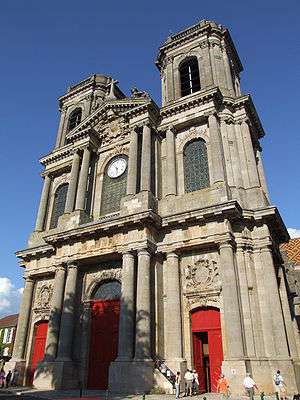 Saint-Mammès Cathedral
Saint-Mammès Cathedral Saint-Mammès Cathedral
Saint-Mammès Cathedral Saint-Mammès Cathedral
Saint-Mammès Cathedral Saint-Mammès Cathedral
Saint-Mammès Cathedral Saint-Mammès Cathedral Cloister
Saint-Mammès Cathedral Cloister Saint-Mammès Cathedral Cloister
Saint-Mammès Cathedral Cloister Bas relief at Saint-Mammès Cathedral
Bas relief at Saint-Mammès Cathedral Moulins Gate
Moulins Gate Moulins Gate
Moulins Gate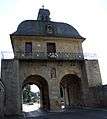 Moulins Gate
Moulins Gate Ramparts of the Citadel
Ramparts of the Citadel Ramparts and Funicular
Ramparts and Funicular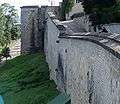 Saint-Ferjeux Tower
Saint-Ferjeux Tower Navarre and d'Orval Tower
Navarre and d'Orval Tower Navarre and d'Orval Tower
Navarre and d'Orval Tower Navarre and d'Orval Tower ceiling framework
Navarre and d'Orval Tower ceiling framework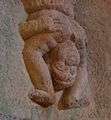 Navarre and d'Orval Tower torch holder
Navarre and d'Orval Tower torch holder Navarre and d'Orval Tower torch holder
Navarre and d'Orval Tower torch holder Navarre and d'Orval Tower gargoyle
Navarre and d'Orval Tower gargoyle Navarre and d'Orval Tower
Navarre and d'Orval Tower Navarre and d'Orval Tower
Navarre and d'Orval Tower Navarre and d'Orval Tower
Navarre and d'Orval Tower Navarre and d'Orval Tower well
Navarre and d'Orval Tower well Navarre and d'Orval Tower vaulted arch
Navarre and d'Orval Tower vaulted arch Former Jesuit College
Former Jesuit College Renaissance cellar
Renaissance cellar Entrance to City Hall
Entrance to City Hall Statue of Denis Diderot
Statue of Denis Diderot Renaissance period mansion
Renaissance period mansion Renaissance period mansion
Renaissance period mansion Henriot Square
Henriot Square Saint-Martin Church
Saint-Martin Church
References
- ↑ "Données climatiques de la station de Langres" (in French). Meteo France. Retrieved December 31, 2015.
- ↑ "Climat Champagne-Ardenne" (in French). Meteo France. Retrieved December 31, 2015.
- ↑ "Normes et records 1961-1990: Langres (52) - altitude 467m" (in French). Infoclimat. Retrieved December 31, 2015.
- ↑ "British towns twinned with French towns". Archant Community Media Ltd. Retrieved 2013-07-11.
External links
| Wikimedia Commons has media related to Langres. |
- Catholic Encyclopedia: Diocese of Langres
- Langres official website (in French)
.svg.png)